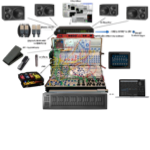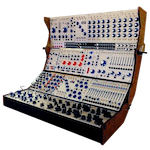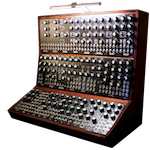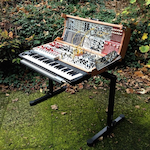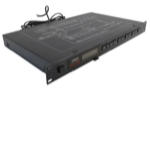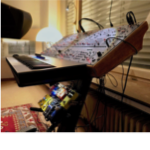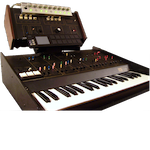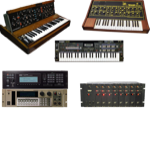KOBOL Expander

Behringer did it again!
Reviving the Kobol expander was a curious idea. Only Behringer can do it so well and then offer the instrument for € 169. After only a short time, I purchased a second Kobol. For me, the B-ARP 2600 Gray Meanie was the first masterpiece of the Behringer synthesizer workshop - the little Kobol has turned out just as well!
A little history first:
The original from RSF (Ruben & Serge Fernandez)
The choice was curious because the RSF Kobol was a rather unknown instrument. The patch points in particular made the Kobol expander an ideal further development of the keyboard version of the Kobol, of which around 200 were built between 1978 and 1982. The “keyboard” Kobol synthesizer was similar to the Minimoog, sounded excellent, but had no patch points.

The photo shows the RSF Expander Kobol in the lower half and the RSF Expander II in the upper half, which has exclusively sound-altering processors (auxiliary modules) and which turns the Kobol into a very complex synthesizer.
However, the complete instrument was a rack quartet. There was also the RSF Programmer with 16 CV pots, which could be stored in 16 (2x8) presets. It also had a small Sequencer with 2x8 steps that could sequence both pitches and presets. A Programmer could address up to 4 Expander Kobol via rear connections.
 The Expander Kobol and Expander II were introduced in 1979, followed shortly afterwards by the “Programmer” and a specialized keyboard mixer, the “KM-8” with FX send/return (the fourth rack). The whole instrument was (ideally) played via the “Polyclavier” (8x CV/Gate Out), and the Polyclavier offers an interesting insight into the fantastic overall concept of the Fernandez brothers' expander rack idea, if only because of its control panel. It was state of the art at that time.
The Expander Kobol and Expander II were introduced in 1979, followed shortly afterwards by the “Programmer” and a specialized keyboard mixer, the “KM-8” with FX send/return (the fourth rack). The whole instrument was (ideally) played via the “Polyclavier” (8x CV/Gate Out), and the Polyclavier offers an interesting insight into the fantastic overall concept of the Fernandez brothers' expander rack idea, if only because of its control panel. It was state of the art at that time.
 Up to 4 Expander Kobol can be played as one instrument via the Polyclavier's 8-voice polyphonic keyboard. In addition, (several) further Programmer and Expander II can be connected. The small photo shows the back of a “Programmer” rack, which could be equipped with up to 4 cards to create normalized connections between the devices, which are interrupted by plugged-in patch cables in the other racks. Only around 200 of each of the RSF Kobol, Expander II, Programmer and KM-8 were produced. However, the large and heavy-looking racks weighed only 3 kg (each) and had a surprisingly low profile.
Up to 4 Expander Kobol can be played as one instrument via the Polyclavier's 8-voice polyphonic keyboard. In addition, (several) further Programmer and Expander II can be connected. The small photo shows the back of a “Programmer” rack, which could be equipped with up to 4 cards to create normalized connections between the devices, which are interrupted by plugged-in patch cables in the other racks. Only around 200 of each of the RSF Kobol, Expander II, Programmer and KM-8 were produced. However, the large and heavy-looking racks weighed only 3 kg (each) and had a surprisingly low profile.
 At Jean-Michel Jarre's China concert with his band in 1981, Frederick Rousseau - and not J.M. Jarre, as is often reported - probably played the RSF expanders shown (and an ARP 2600), but Jean-Michel Jarre apparently owned the largest Kobol instrument ever realized, which may explain the astonishing degree of popularity among “experts”. However, the company RSF went bankrupt the following year (1982) - as had ARP Instruments the year before, despite being the “market leader”. On the advertising photo I can identify 4x Expander Kobol, 2x Programmer, 1x Expander II, 1x KM-8 and the Polyclavier.
At Jean-Michel Jarre's China concert with his band in 1981, Frederick Rousseau - and not J.M. Jarre, as is often reported - probably played the RSF expanders shown (and an ARP 2600), but Jean-Michel Jarre apparently owned the largest Kobol instrument ever realized, which may explain the astonishing degree of popularity among “experts”. However, the company RSF went bankrupt the following year (1982) - as had ARP Instruments the year before, despite being the “market leader”. On the advertising photo I can identify 4x Expander Kobol, 2x Programmer, 1x Expander II, 1x KM-8 and the Polyclavier.
Olivier Grall's photos and the scan of the advertisement are taken from the official RSF-Website.
 You can see a trio with Expander Kobol, Expander II and Programmer here (I took the photo from a forum that I unfortunately can't find anymore). Recently, such a set of 3 was offered for sale for just over € 30,000 (thirty thousand euros!) - 20 times the original price! The original prices were the equivalent of € 550.- (Expander Kobol), € 450.- (Expander II), € 490.- (Programmer) - for € 370.- there was the Keyboard-Mixer (KM-8), which is not present here.
You can see a trio with Expander Kobol, Expander II and Programmer here (I took the photo from a forum that I unfortunately can't find anymore). Recently, such a set of 3 was offered for sale for just over € 30,000 (thirty thousand euros!) - 20 times the original price! The original prices were the equivalent of € 550.- (Expander Kobol), € 450.- (Expander II), € 490.- (Programmer) - for € 370.- there was the Keyboard-Mixer (KM-8), which is not present here.
While the RSF Expander II is a really good, important and useful extension of the Kobol, as it offers practically everything you could wish for in terms of modulation processors, I consider the Programmer, which was a real technical refinement at the time, to be obsolete today because its functions (as far as I understand it) could now be produced (i.e. programmed) relatively easily and much more complex. The Programmer can be used to create and save presets. These three devices together were, so to speak, the “upgraded” form of the Kobol synthesizer with keyboard (and therefore much more versatile). The keyboard and modulation wheels of the Kobol synthesizer were now available in the “Polyclavier” in a similarly upgraded form.
RSF had built an instrument (the Kobol Expander Quartet) that was on the same level as the very best synthesizers of the time. Thanks to the Programmer, they were even at the forefront of development. Then, the Keyboard Mixer made it possible to loop in selected effect devices in addition to the perfect mix. Really well thought out and fantastically realized!
I
The Behringer Kobol Expander
Although the Kobol Expander has a very simple structure, you can create very, very beautiful sounds even without the Expander II and Programmer, especially thanks to the patch I/Os. In this (reduced) form, it is particularly suitable for melodious playing and is also good for rich basses! The simplicity of this instrument is also its strength, because it promotes the joy of playing and simplifies the possibility of an immediate musical reaction.
actually planned the Kobol as a sonic counterpart to the B-ARP 2600, but immediately realized that it works incredibly well as a colorful, analog lead voice together with the polyphonic Yamaha TX81Z. The Yamaha TX81Z is digital and works with FM synthesis - and therefore without a subtractive filter. Here the Kobol (with filter) creates the contrast. As a rule, you don't want to change individual voices in a polyphonic section, as this would destroy the tonal unity. An additional, analog, subtractive lead voice can be modulated slightly using filters and portamento, for example, so that it sounds like a soloist voice that stands out from the (chordal and homogeneous sounding) movement. For this function, the Behringer Kobol is really the most suitable instrument for me (in my arsenal), because it is small and simple and yet can produce somewhat more sophisticated sounds thanks to the patch points!
Design of the Kobol
 The structure of the Kobol is very simple and can be easily understood thanks to the panel design. Two VCOs, each with 7 waveforms, and a Noise Generator (White and Pink) are available for creating sounds. The VCOs can be switched to sync mode. A special feature is that the 7 waveforms of the VCO are not switched, but interpolated. A simple LFO (triangle and square) and a simple, very useful voltage processor are also provided. Both have a well thought-out special feature: the LFO has two patch points at the OUTputs. LFO OUT 1 is controlled by the “Volume” pot (and simultaneously added to the Kobol sound) and LFO OUT 2 is directly transmitted - so the LFO rate can be used to clock a sample/hold module (in the expander), for example (while the LFO in the Kobol is muted). The same, only in reverse, applies to the Voltage Processor Input: While the input volume of IN 1 is adjusted via the “IN 1 Gain” control, IN 2 runs directly to the “OUT Gain” control. Both are fundamentally important if you want to connect something like an Expander II.
The structure of the Kobol is very simple and can be easily understood thanks to the panel design. Two VCOs, each with 7 waveforms, and a Noise Generator (White and Pink) are available for creating sounds. The VCOs can be switched to sync mode. A special feature is that the 7 waveforms of the VCO are not switched, but interpolated. A simple LFO (triangle and square) and a simple, very useful voltage processor are also provided. Both have a well thought-out special feature: the LFO has two patch points at the OUTputs. LFO OUT 1 is controlled by the “Volume” pot (and simultaneously added to the Kobol sound) and LFO OUT 2 is directly transmitted - so the LFO rate can be used to clock a sample/hold module (in the expander), for example (while the LFO in the Kobol is muted). The same, only in reverse, applies to the Voltage Processor Input: While the input volume of IN 1 is adjusted via the “IN 1 Gain” control, IN 2 runs directly to the “OUT Gain” control. Both are fundamentally important if you want to connect something like an Expander II.
 The right-hand side of the panel is just as simply structured. Here you will find a nice-sounding 24dB LoPass Filter, which can be driven into self-oscillation with the resonance control, plus a control that can adjust the filter frequency to the pitch played and a control for driving the filter with the second envelope. On the far right are the two simple ADS envelope generators, ADS 1 and ADS 2. ADS 2 is intended for the filter. For external audio signals, there is the “VCF Audio IN” patch point - the incoming signal is summed with the VCOs before passing the Filter.
The right-hand side of the panel is just as simply structured. Here you will find a nice-sounding 24dB LoPass Filter, which can be driven into self-oscillation with the resonance control, plus a control that can adjust the filter frequency to the pitch played and a control for driving the filter with the second envelope. On the far right are the two simple ADS envelope generators, ADS 1 and ADS 2. ADS 2 is intended for the filter. For external audio signals, there is the “VCF Audio IN” patch point - the incoming signal is summed with the VCOs before passing the Filter.
As a “full-fledged” synthesizer, this may still seem a bit limited, but the components included in the Kobol are perfect for “simple tasks” - and the patch points make it possible to create more complex sounds even with this simple set of features.
However, if you want to play the Behringer Kobol as a “complete” synthesizer, you should have something like the Expander II, because it contained everything you could miss in the Kobol: Envelope Follower, Voltage Processor (with LAG / SLEW), a more conductive LFO (Triangle, Sawtooth, Square, Sample & Hold), Ring Modulator, Noise Generator, Gate Delay, 3 In 1 Out Mixer, ADSR Envelope, another VCA and 2x Multiples. As the Behringer Expander Kobol is also a Eurorack module, it makes sense to implement the functions of the Expander II using Eurorack modules.
After a brief attempt to expand it with Eurorack modules and Max patches, however, I opted for a compromise solution (a small expander) - the operation of the instrument became too complex and “too technical” for me. The additional modules and the numerous patch cables destroyed the simplicity of this instrument, which has a very special appeal for me. I already do more complicated things with Buchla and MOTM and that's enough for me. However, some functions of the Expander II can already be added to the Kobol with a “Kenton Modular Solo” module, for example. The Portamento in particular, but also the additional LFO of the module are essential additions. However, my first extension of the Kobol consisted of a second Kobol. More about this below.
Behringer's Desktop-Standalone/Eurorack Concept
I wasn't very interested in the first synths in this series and I have to admit that I wasn't attracted to the downsizing at first. I had owned a Moog Mini Model D and an EDP Wasp Deluxe in the past (both part of this series), which caught my attention. However, the Behringer reinterpretation of the ARP 2600 (which I also owned in the original) had absolutely thrilled me, and with the Gray Meanie my pleasure of playing synthesizers without computer support came back. The Expander Kobol had aroused my curiosity - and both the Kobol and the desktop/Eurorack concept quickly convinced me.
PolyChain
 This desktop series offers the “PolyChain” (MIDI) mode, which (I think) only works in the desktop case, because USB IN, MIDI OUT and the MIDI channel DIP switches are on the case and not on the (Eurorack) front panel.
This desktop series offers the “PolyChain” (MIDI) mode, which (I think) only works in the desktop case, because USB IN, MIDI OUT and the MIDI channel DIP switches are on the case and not on the (Eurorack) front panel.
In PolyChain mode, up to 16 expanders ( in this case with MIDI channels 1-16) can be connected via MIDI cable and it is possible to play the Kobol polyphonically. It works like this: 1st tone = MIDI ch1, 2nd tone = ch2, 3rd tone = ch 3... If the maximum number is exceeded, the 1st tone will be replaced again. The parameter values are not transmitted.
For me, PolyChain, especially on the Kobol, is not particularly interesting. You can play polyphonically, but to use it properly, you need a few workarounds. PolyChain also taps through the MIDI channels when the keys are played singly. Because several Kobol(de) can only be set “identically” in a time-consuming process, it is already unsatisfactory. In particular, the setting of the stepless waveforms drags the process out somewhat. In addition, if, for example, you play legato with two Kobols- i.e. possibly creating slight overlaps (which requires an additional voice) - a lying note is simply cut off. The “newest/highest/lowest” MIDI note priority is not a satisfactory solution to this problem. This fact doesn't bother me - my interest is rather in the combination of two Kobol for a higher complexity of the resulting sounds.
Conclusion
The Kobol has turned out really well. It's a wonderful and (very) small synth that I can't find anything wrong with. On the contrary: it sounds amazingly good, has character, surprises with sounds that you would hardly have thought possible on such a small synth and it makes me happy when I play it.
Behringer not only offers a price that is out of competition and thus lowers the barriers to the synthesizer world, but this concept also allows beginners in particular to “evolve” (by switching from desktop synthesizer to Eurorack) without having to accept major financial losses or “losing” their first instrument from the system - they can seamlessly switch to the modular concept and continue to play the Kobol front panel as an Erorrack module. This option is certainly also welcome for the more advanced players. Truly great!
It is also amazing that Behringer once again manages to leave a positive personal imprint in the successful revival of the Kobol.
And just like with the 2600 Gray Meanie, all I can do is take my hat off: Chapeau, Behringer! Very, very good work!
The Kobol on the Behringer website: Kobol Expander
II
The expansion of the Behringer Kobol
Even 40 years later, I still think it's a very good idea to move the modulation modules to the Expander II and separate the sound generators in order to address several Kobol with just one Expander II (see RSF advertising photo). That's why I was tempted to recreate the three other RSF racks - Expander II, Programmer and KM-8 - possibly with Eurorack modules and successively with MAX-patches and to add a second Kobol. It will be played via a Launchkey mk3 keyboard, which, in addition to a sustain pedal, mod wheel and pitch bend wheel, also offers 8 MIDI controllers and (most importantly) 16 pads (both of which can be assigned multiple times), and I also use a Lehle Dual Expression Pedal and an iPad.
__________________
The Features of the RSF Expander II
 are the starting point for this project, which is why I have outlined them in yellow. On the far left, there is a 1to2 multple at the top and a 1to3 multple at the bottom (without labeling). For a setup without a computer, the two (very affordable) Behringer modules 150 and 130 of the Roland M Series Replication could be considered, because they already offer a good part of the functions of the RSF Expander II (RM, LFO, S/H, Noise [150] and 2x 3 IN/1 OUT mixer, or 1x 3 IN/1 OUT mixer plus sum VCA [130]).
are the starting point for this project, which is why I have outlined them in yellow. On the far left, there is a 1to2 multple at the top and a 1to3 multple at the bottom (without labeling). For a setup without a computer, the two (very affordable) Behringer modules 150 and 130 of the Roland M Series Replication could be considered, because they already offer a good part of the functions of the RSF Expander II (RM, LFO, S/H, Noise [150] and 2x 3 IN/1 OUT mixer, or 1x 3 IN/1 OUT mixer plus sum VCA [130]).
It was just a mind game at first. My sketch shows the planning for the idea of a maximized “remote control” of the double Kobol with Eurorack and computer. However, since the integration of a computer would be indispensable and I would rather keep the Kobol small and play without a computer, I quickly discarded the idea of complete control (more details under “Recap on the expansion").
 The two gray modules are the above-mentioned Behringer 130 and 150. From my Eurorack stocks come the Kenton Modular Solo (MIDI to CV), an Expert-Sleepers ES-40 with five CV expanders (40 x CV), the TipTop Z4000 ADSR Generator and a 2x3 Buffered Multiples from “After Later Audio”. A 2TE Gate Delay from the same manufacturer is planned. Ring Modulation, CV-Processor, LFO, ADSR, Envelope Follower, LAG/Slew and Gate Delay could also be realized exclusively with Max-patches (via ES-CV). However, I prefer to have the Mixer and VCA as modules.
The two gray modules are the above-mentioned Behringer 130 and 150. From my Eurorack stocks come the Kenton Modular Solo (MIDI to CV), an Expert-Sleepers ES-40 with five CV expanders (40 x CV), the TipTop Z4000 ADSR Generator and a 2x3 Buffered Multiples from “After Later Audio”. A 2TE Gate Delay from the same manufacturer is planned. Ring Modulation, CV-Processor, LFO, ADSR, Envelope Follower, LAG/Slew and Gate Delay could also be realized exclusively with Max-patches (via ES-CV). However, I prefer to have the Mixer and VCA as modules.
With 46 CV outputs, this setup would also provide enough CV outputs to implement the RSF Programmer Rack.
The RSF Programmer
 The connections of the 16 controllers are labeled on the RSF programmer - in other words, they have a fixed assignment. I have color-coded them in the picture. The realization with Max and iPad would even overcome a disadvantage of the original concept: the pots would display the current positions even after preset changes. The small Sequencer contained in the RSF Programmer could also be easily implemented in Max - even on a larger scale.
The connections of the 16 controllers are labeled on the RSF programmer - in other words, they have a fixed assignment. I have color-coded them in the picture. The realization with Max and iPad would even overcome a disadvantage of the original concept: the pots would display the current positions even after preset changes. The small Sequencer contained in the RSF Programmer could also be easily implemented in Max - even on a larger scale.
Now it was time to reflect once again on all the additions:
Recap on the expansion
Two things stood out in this game of thought: first of all the (very pleasant) simplicity of the Kobol, which would be lost due to all the modules and patch cables, and secondly the financial effort required for a complete controller! The controller alone is not exactly a bargain at around € 1500 - and it would significantly increase the size of the setup with a computer and additional controllers. The complete expansion (i.e. only the middle module series) would already cost around € 2400 (new price) despite the inexpensive Behringer modules. But because I had the Kenton Modular Solo and an ES-40 with a complete expander set to hand, I was able to put the control system into practice. A third point became clear: both Kobol have 6 switches - so there would still be 12 - including the Behringer modules even 17 - switches to check for each preset change! You can't really call that a “preset” any longer…
Of course I only speak for myself - these are not generally valid statements, but I have rejected the idea of complete control of my Kobols. 1) I already own two complex modular systems and don't want a third. 2. since I don't use the Kobol for repertoire concerts where quick switching of sounds (presets) is necessary, such extensive control is more of a hindrance than a relief. 3. the Kobol is direct and uncomplicated (and should remain so)!
Realization of the Expander
There is nothing to be said against the purchase of a second Kobol. If you play two Kobol as one instrument (on the same MIDI ch), the sounds can be created much more complex. It almost gave me the feeling that I might not need an Expander at all. What I missed, however, was a Portamento function (LAG), which I obtained (without a computer) with the “Kenton Modular Solo”. As this module also comes with an extensive LFO, it is actually enough to satisfy my needs. But I still was curious about the impact of an Expander.
 In order to be able to continue playing the Kobol “easily” (i.e. without the Expander) using only a MIDI keyboard (and to be able to transport it more easily), I first constructed a 2x30 HP extension that can be docked onto my double Kobol. It contains the Kenton Modular Solo, Multiples, ADSR, Dual VCA, Vector Mixer and a Joystick. Instead of a 3 IN -> 1 Out mixer, I use an Antimatter Vector Mixer (4 In -> 1 Out) in conjunction with a Joystick and µVCA.
In order to be able to continue playing the Kobol “easily” (i.e. without the Expander) using only a MIDI keyboard (and to be able to transport it more easily), I first constructed a 2x30 HP extension that can be docked onto my double Kobol. It contains the Kenton Modular Solo, Multiples, ADSR, Dual VCA, Vector Mixer and a Joystick. Instead of a 3 IN -> 1 Out mixer, I use an Antimatter Vector Mixer (4 In -> 1 Out) in conjunction with a Joystick and µVCA.
Unfortunately, the “Frankensynth” design destroys the very beautiful, homogeneous appearance of the Kobol…
In use
 Now the synth is 60 cm wide, so it's still quite “small”. The Vector Mixer is very “expanding” - especially now that RM is in the instrument. I prefer the Joystick control over multiple knobs. The Ring Modulation is the most obvious tonal change and very appealing. S/H is also not to be sneezed at. My two old Disting mkI perform amazingly well here. The first starts as S/H (including Noise Output) as the default setting, the second starts as a Ring Modulator.
Now the synth is 60 cm wide, so it's still quite “small”. The Vector Mixer is very “expanding” - especially now that RM is in the instrument. I prefer the Joystick control over multiple knobs. The Ring Modulation is the most obvious tonal change and very appealing. S/H is also not to be sneezed at. My two old Disting mkI perform amazingly well here. The first starts as S/H (including Noise Output) as the default setting, the second starts as a Ring Modulator.
 The 4HP narrow Disting from Expert Sleepers is the ideal module for replacing the Expander II. In addition to RM and S/H, it offers LFO, Envelope Follower with Pitch Tracker, Slew Rate (LAG), Waveshaper, Quantizer, Rectifier, Comparator and even two types of VCOs ... The “Disting Cheat Sheet” shows all 16 available settings.
The 4HP narrow Disting from Expert Sleepers is the ideal module for replacing the Expander II. In addition to RM and S/H, it offers LFO, Envelope Follower with Pitch Tracker, Slew Rate (LAG), Waveshaper, Quantizer, Rectifier, Comparator and even two types of VCOs ... The “Disting Cheat Sheet” shows all 16 available settings.
The current state:
 I like the separation of the Synths and Expander and the compact size is convenient for me. It was mainly the Portamento that I really wanted and for that I had to use at least one Eurorack module. The many additional possibilities created by a few modules are opening the doors to more abstract sounds and other musical worlds without changing the instrument (or its dimensions) too much. All the functions of the RSF Expander II have been implemented, only the gate delay is still lacking. Now I will try the Doepfer Mixer 138s with 4xIN and 2xOUT as an additional mixer (router). Thanks to the Panorama knobs, I can also use one output for the (mono) Pedalboard (in “dual mono” mode) to redirect the signals. I am looking to realize the Voltage Processor of the RSF Expander II with the Aux outputs of the Kenton and will use the MIDI controls of the keyboard to control the additional LFO (+ S/H) of the Kenton.
I like the separation of the Synths and Expander and the compact size is convenient for me. It was mainly the Portamento that I really wanted and for that I had to use at least one Eurorack module. The many additional possibilities created by a few modules are opening the doors to more abstract sounds and other musical worlds without changing the instrument (or its dimensions) too much. All the functions of the RSF Expander II have been implemented, only the gate delay is still lacking. Now I will try the Doepfer Mixer 138s with 4xIN and 2xOUT as an additional mixer (router). Thanks to the Panorama knobs, I can also use one output for the (mono) Pedalboard (in “dual mono” mode) to redirect the signals. I am looking to realize the Voltage Processor of the RSF Expander II with the Aux outputs of the Kenton and will use the MIDI controls of the keyboard to control the additional LFO (+ S/H) of the Kenton.
The Modgrid picture only shows the front view. Of course, an additional power supply is necessary. I have attached a Behringer CP1-A to the back of the expander for this purpose.
_________
Afterthought
I don't want to turn the Kobol into a jack-of-all-trades that I can use to produce all the sounds in the world, I just want to be able to quickly set up useful sounds that I can play with. However, without a computer connection, you'll need a few FX pedals with every analog synth.
More about my Pedalboard is here:
the FX-Pedalboard
The Behringer Kobol is a really well-elaborated synthesizer!



